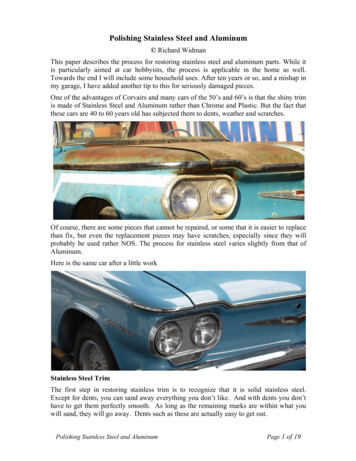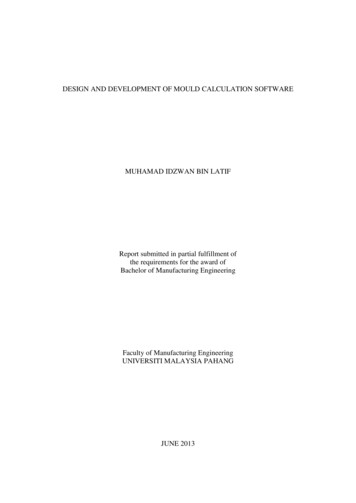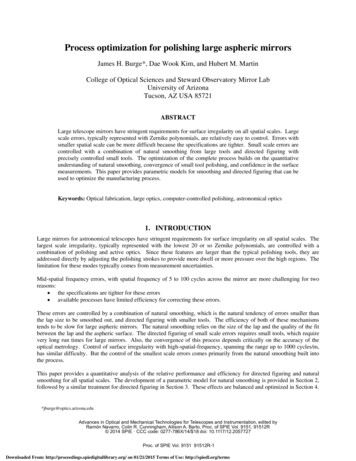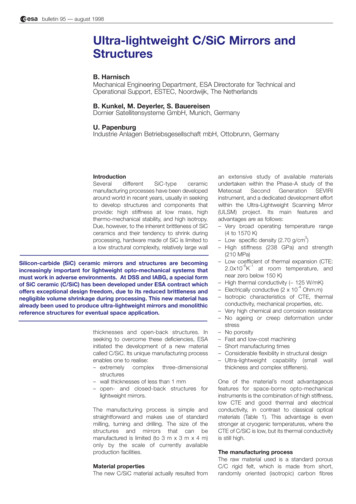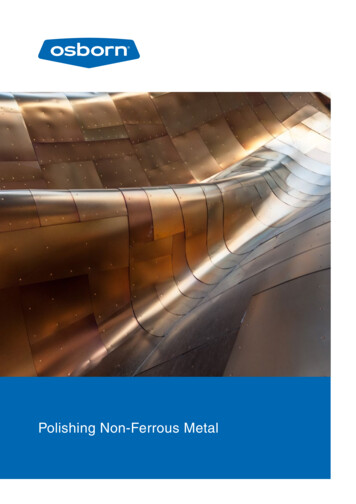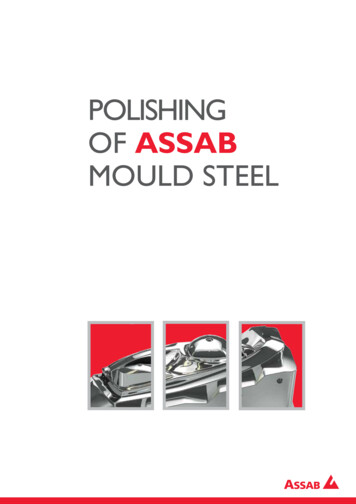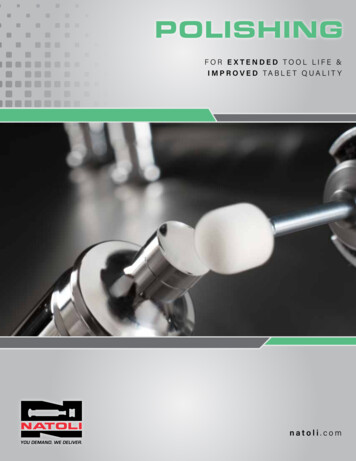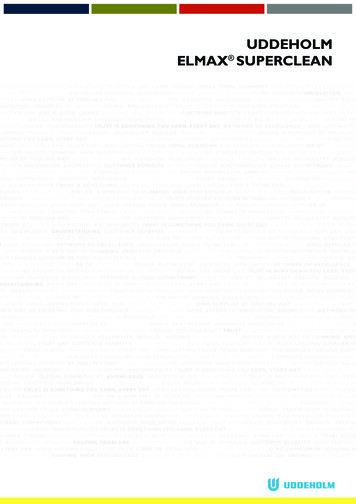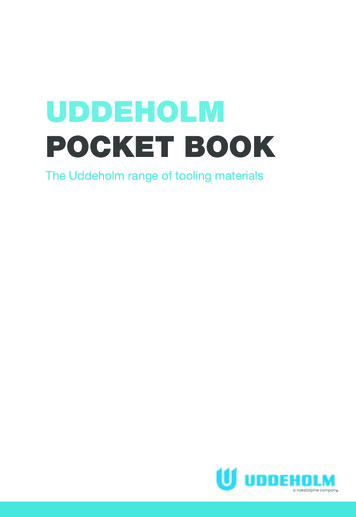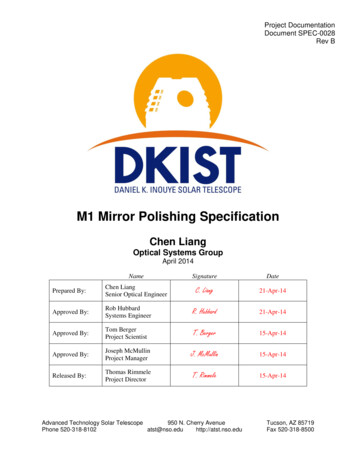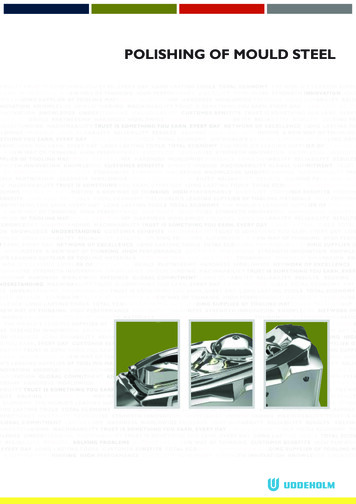
Transcription
POLISHING OF MOULD STEEL
UDDEHOLMS ABNo part of this publication may be reproduced or transmitted for commercial purposeswithout permission of the copyright holder.This information is based on our present state of knowledge and is intended to provide generalnotes on our products and their uses. It should not therefore be construed as a warranty ofspecific properties of the products described or a warranty for fitness for a particular purpose.Classified according to EU Directive 1999/45/ECFor further information see our “Material Safety Data Sheets”.Edition 6, 07.2014The latest revised edition of this brochure is the English version,which is always published on our web site www.uddeholm.comSS-EN ISO 9001SS-EN ISO 14001
POLISHING OF MOULD STEELCONTENTSWhy strive for a high surface finish4Factors that affect the surface finish4Surface preparation of tool steels6Guidelines7Polishing problems can be solved10Measuring surface roughness and quality113
POLISHING OF MOULD STEELWhy strive for ahigh surface finish?Plastic and metallic components aremanufactured with various surfacefinishes all from shiny and glossy tofunctional surfaces of differentappearances. In this brochure we willinform about the factors that havethe biggest impact on the polishabilityof tool steels and give recommendations on how to obtain the requiredsurface finish on moulds, dies,punches and metallic components/parts. The most common defects areshown in the Uddeholm brochure“Defect Chart and Hints for HighGloss Polishing of Steel Surfaces”Depending on the application andrequirements we can distinguish between two types of surface finishingmethods; high gloss polishing andfunctional polishing.High gloss polishingTools for plastic moulding do requirea high surface finish especially whenextreme transparency and/or highgloss are aimed for. In such cases it isof utmost importance to choose aproper tool material and establish asuitable surface preparation technique. To achieve a reflective surfacewith mirror finish the preparationprocess must involve several grindingand diamond polishing steps andthese have to be performed in aclean workplace. The use of properworking tools facilitates the processa lot.High surface finish reduces the riskof local corrosion and fracture orcracking due to temporary over loading or pure fatigue.The tool surface finish may alsohave an impact on productivity as inthe case of injection moulding. Here,the release forces of the plastic component from the tool steel surfaceare dependant on the adhesion properties of the polymer to the mouldsurface. An improved smoothness ofthe tool surface may lead to higherrelease forces and eventually to sticking phenomena, which partly can be4overcome by an optimal choice oftool steel and preparation strategy.Factors that affectthe surface finishFunctional polishingTool steels are used in many application fields within plastic moulding,cold and hot working and as engineering components. For properfunctionality, but also to minimize themanufacturing cost of the tool orcomponent it is vital to specify therequired surface finish on the engineering drawing. Especially in applications of plastic moulding it is important to have access to material datarelating to surface finish capabilities.However, it should be noted that thesurface finish of the end product isnot only determined by the tool steeland the applied surface preparationprocess, but also the applicationprocess itself has a big impact on theresult. Polymers have different material characteristics at plastic mouldingand this will definitely influence thefinal surface finish, as illustrated inFigures 1 and 2.Most cold work applications do notneed high gloss polished tool surfaces, but it is always advantageous tocreate functional surfaces for a prolonged tool life. In forming operationswhere lubricants are involved apreparation strategy may consist ofremoving larger peak formations onthe surface and preserving a controlled depth of valleys as lubricationpockets, which then will contributeto a reduced friction during forming.However, it is always important toconsider the final tool steel surfacequality in relation to the application.If a high quality surface coating isgoing to be applied, then it is alwaysrecommended to perform high glosspolishing of the tool surface beforethe coating process.The polisher isextremely importantThe results from the tests that havebeen carried out during the workwith this brochure shows that theskill, experience and technique of thepolisher plays an extremely important role in achieving the desiredsurface finish.ApplicationPolishingtechniqueType of polymerType oftool steelSurface qualityPre-preparationof the surfaceProcess routeHeat treatmentFig.1. A number of factors have influence on thesurface finish of the final end 2000µm0500 1000 1500 2000 2500 µm0500 1000 1500 2000 2500 µm025050075010001250150017502000µmTool surface, inverted2505007501000125015001750Makrolon AL2647(Medium viscosity)2000µmBayblend T45(Low viscosity)Fig 2. The photos show differently holes/pits on tool surface replicated on the plastic plaquedue to different material characteristics in different polymers. Fewer peaks is detected onthe Makrolon plaque whereas the Bayblend plaque had visible peaks all over the surface.
POLISHING OF MOULD STEELTool steel qualityCONVENTIONAL PROCESSPROCESS ROUTES FOR TOOL STEELSUDDEHOLM STEEL GRADES:Tool steels are found in various alloycombinations to fit usage in differentapplication fields. Common manufacturing process routes are conventional ingot casting (IC), continuouscasting (CC), electro slag remelting(ESR), vacuum arc remelting (VAR)and powder metallurgy (PM). Remelting processes and PM processes produce materials of higher homogeneitywith a low non-metallic inclusioncontent, whereas ingot cast materialsnormally have a higher degree ofsegregation patterns and also containmore non-metallic inclusions.CALMAXRIGORIMPAX SUPREMENIMAXRAMAX HHORVAR 2 MICRODIZEDCORRAXELECTROSLAG REMELTINGPROCESSUDDEHOLM STEEL GRADES:STAVAX ESRMIRRAX ESRMIRRAX 40ORVAR SUPREMEVIDAR 1 ESRUNIMAXDIEVARRecommendationsTo produce highly reflective andglossy surfaces ESR-remelted or PMsteels are to be used. However,conventional ingot cast steels cangive a very good surface finish, ifboth steel manufacturing andpolishing are performed accordingto a good practice.POWDER METALLURGYPROCESSUDDEHOLM STEEL GRADES:VANADIS 4 EXTRAVANADIS 10ELMAXFig 3. Process routes for tool steels andexample of steel grades produced by thedifferent routes.DEFECTS IN TOOL STEELSVarious types of defects emanatingfrom the production process may befound in the steel. During steelmakingnon-metallic inclusions are formed asa result of the deoxidation process.Other sources are entrapped exogenous material from refractory inthe ladle or at casting. A fast solidification rate is normally beneficial bygiving less time for inclusions andparticles to grow and reducing segregation patterns.In the special remelting processessuch as VAR and ESR the cast ingotare remelted under controlled conditions. Non-metallic oxide inclusionsare effectively removed from thesteel and sulphides are reducedsubstantially via the basic workingslag in the ESR-process altogethergiving tool steels of high cleanliness.The remelting processes direct thecasting structure in such a way thatmacro segregations are drasticallyreduced and a more uniform microstructure is created, which is beneficial from polishing point of view.Total number of particles per mm2 *(oxides sulphides carbides nitrides)Polishability rank5Bad10004100ELTE3COTSSTAING21Good PM101ESR REMELTED STEELLowHighDefect content by inclusions and carbides0.1PMESRConventional*oxides and sulphides 3µm carbides and nitrides 4µmFig. 4. A low defect content is beneficial from polishing point of view.5
POLISHING OF MOULD STEELHEAT TREATMENTHeat treatment can affect polishability in many ways. Decarburizationor recarburization of the surfaceduring heat treatment can producevariations in hardness, resulting inpolishing difficulties.In order to avoid this it is recommended that the hardening is carriedout in vacuum furnaces or furnaceswith controlled protective gas atmosphere or salt baths. It is also of importance to secure that the time ataustenitizing temperature is not toolong and the quenching speed is nottoo slow to avoid grain growth andgrain boundary precipitations.Surface preparationof tool steelsThe following four terms are commonly used when it comes to surfacepreparation of tool steels. Theessential characteristics of thesemethods are explained below.GRINDINGThe abrasive particles are firmlybonded to a carrier such as grindingpaper, stones and the discs.ASampleBGlueBackingLAPPINGThe abrasive particles are notbonded but move freely between thecarrier and the work piece.ASampleBSuspensionManufacturingof initial surfacesIt should be emphasized that thegrinding operation forms the basis fora rapid and successful polishing job. Ingrinding, the marks left by the roughmachining operation are eliminatedand a metallically pure and geometrically correct surface is obtained.The finishing preparation steps canbe very time consuming and costly,but can be controlled to a certainextent by a proper manufacturing ofthe initial tool surface. Normally thestarting surface is ground, milled orelectro discharge machined (EDM).Typical initial surface roughnessvalues, as Ra/Rz, are approximately0.5/5 µm for the two former and3/15 µm for an EDM surface. Recentdevelopments in high speed machining has made it possible to producesurface finishes better than Ra 0.2 µm and by using the latest techniques in EDM the Ra falls below0.07 µm. After EDM processing it isimportant to remove the heat affected layers by either a fine sparkingand/or by grinding. If not doing socrack initiation may appear duringtool use.SupportHints for grindingPOLISHINGOPERATIONThe abrasives are more or less fixedin the carrier material and will cutand/or plough the surface.SampleAGroundMilledHigh speedmachinedEDMSURFACE FINISHRa 0.5 µmRa 0.5 µmRz 5 µmRz 5 µmRa 0.2 µmRa 3.0 µmRz 1.5 µmRz 15 µmTable 1. Typical initial surface roughnessvalues Ra and Rz.BRecommendationsBUFFINGThe abrasive adhere loosely to aflexible carrier (soft disk made ofcloth or hide). This step is consideredamong some polisher to be the lastpolishing step performed in order toobtain a mirror like surface.6To facilitate the finishing steps andto minimize the risk of losingdimensional tolerances of the toolthe initial surface finish should havea roughness value of maximumRa / Rz 0.5/5 µm. This will eliminate the need of using coarse grinding media in the first preparationstep.
POLISHING OF MOULD STEELDescription of abrasivesIt is important that the abrasivefulfills requirements with respect to: hardness sharpness thermal resistance chemical stabilityToday, the following five main groupsof synthetic abrasives are used, fulfilling the above requirements togreater or lesser extents.1. Diamond designation SD2. Aluminium oxide designation A (SG)3. Silicon carbide designation C4. Boron carbide designation B4C5. Cubic boron nitride designation BAbrasives have different applicationareas, depending on their particularcharacteristics, as shown partially intable 2 oroncarbideCBNHARDNESSKNOOPTHERMALSTABILITYIN AIR C F7 00065012002 100200036302 500120021902 9004 70027001300489025503. Silicon carbide (SiC)Has a needle like blocky structure.Used for rougher surface finishes.4. Boron carbide (B4C)Is hard and has a blocky crystal structure. Fast material removal generatingmoderate surface finish.5. Cubic Boron Nitride (CBN)Is produced basically in the same wayas synthetic diamond and is usedwhen grinding hard materials like HSSand hardened high carbide toolsteels.RecommendationsMaterial removal in hardened steelsis more consistent and repeatablewhen diamond products are used.Precision hand tools incorporatinglinear movement of the workingtools, grinding files and polishingstones, give a less troublesomepreparation process. A good practice is to work perpendicular tothe grooves in all preparation stepsand to verify with optical examination that all scratches from theprevious step have been completelyremoved. Note, that heavy coldworked material beneath the surface needs to be removed for aperfect end result.Table 2.1. DiamondThe hardest material known, has asharp and angular structure. Fastmaterial removal and the best possible planarity in combination withexcellent surface finishes.Distinguish between mono andpolycrystalline diamonds. Monocrystalline are best for lapping, sincethey are round and have many cuttingedges. Natural gives better cuts whilesynthetic are harder, a mix is the bestsince it last longer.2. Aluminium oxide (Al2O3)Is relatively hard and has a sharpangular structure. It is often usedduring the last polishing step since itgives excellent and highly glossy surface finishes. Is relatively inexpensive.GuidelinesNo general recipe exists for all typesof steels, but the experience andability to adjust the polishing technique to every single mould and tominor variations in the surface is ofcrucial importance for the end result.As a general guideline the procedurefor high gloss polishing shown belowcan be adopted i.e.; starting from a ground surfacewhere the roughness Ra/Rz shouldbe maximum 0.5/5 µm use stones/grinding papers for thefirst steps, stepwise grinding to1200 Mesh spend more time on the coarsesteps before changing to the finersteps polishing with diamond compoundfrom 15 µm down to 1 µm grain,use as short time as possible always be careful when using softcarriers (felt, brushes, cloths) asthere is a risk of “orange peel”formation on the polished surfaceA reflective surface starts to appearat Ra/Rz approaching 0.1/1 µm, andthe final surface roughness Ra/Rzshould be less than 0.005/0.04 µm fora high gloss polished surface.FINE GRINDINGFine grinding should smooth thesurface before the diamond polishingstage commences. Working tools andcompound media are built up arounddifferent kinds of abrasives whichconsists of small and hard particleswith sharp edges and irregularshapes.PRACTICAL HINTS FOR GRINDINGIt should be emphasized that thegrinding operation forms the basis fora rapid and successful polishing job.In grinding the marks left by therough machining operation are removed and a clean and geometricallycorrect surface is obtained. The practical hints mentioned below apply toboth mechanical grinding and manualstoning. To avoid adding heat and stress intothe surface, do not use too muchpressure and use plenty of coolant. Use only clean and free-cuttinggrinding tools with soft stones forhard surfaces. It is very important that the workpiece and the hands of the polisherare carefully cleaned between eachchange of grain size. This is done toprevent coarse particles and dustfrom being carried over to the nextgrinding step.7
POLISHING OF MOULD STEEL When changing to the next finergrain size, it is recommended thatthe grinding direction be changed to45 . Cross-grinding is very simple,but extremely effective. It increasesstock removal and it makes it easierto detect scratches from the previous steps and improve the dimensional accuracy. Figure 5 A–C. Select the sequence of movementsso that all surface segments areprocessed for an equally longperiod. With a rotating grindingdisc there will be a risk that therewill be less stock removal on theedge than in the centre of thesurface. Figure 5 D.StandardA45 PRACTICAL HINTS FOR POLISHINGAbove all, cleanliness in every step ofthe polishing operation is of suchimportance that it cannot be overemphasized. Each polishing tool should be usedfor only one paste grade and keptin dust proof containers. Paste should be applied to thepolishing tool in manual polishing,while in machine polishing the pasteshould be applied to the workpiece. Polishing pressure should beadjusted to the hardness of thepolishing tool and the grade ofpaste. For the finest grain sizes, thepressure should only be the weightof the polishing tool. Work with hard carriers for asmany steps as possible and workfor as short a period as possiblewith soft carriers. Polishing should start in the corners, edges and fillets but be carefulwith sharp corners and edges sothey are not rounded off.BMillingTurningEDM’ing Finish polishing step should, if possible, be carried out in the releasedirectional of the moulded part. With softer carrier the abrasive isable to penetrate deeper into thecarrier. This will result in that thesurface will be finer for the samesize of abrasive. See Figure 6 below.SoftFeltMediumHardWoodSteelHardened steelFigure 6. The hardness of the carrieraffects the exposure of the diamond grainsand the removal rate.TYPICAL POLISHING SEQUENCESThe choice of grinding and polishingsequences are determined by theexperience of the operator and theequipment he/she has at his/herdisposal. The properties of the toolmaterial can also influence thesequence.RoughgrindingRough Grainnumber90 5080C120180Irregular overlappingFine 220FinegrindingRough GrainD320Fig. 5. Grinding directions.FEPAPolishing withdiamond pasteRough Micronsize45 µm25800151200Fig. 7. This figureshows example of howthe polishing sequencecan be selected.89631FineFine
POLISHING OF MOULD STEELEXAMPLE OF DIFFERENTPOLISHING STRATEGIES AT HIGHGLOSS POLISHINGAll polishers have their own procedures for high gloss polishing. Thedata, in Tables 3–5, reflects that differ-ent manual polishing strategies canbe adopted to reach the same finalsurface finish by using rigorous andwell proven working procedures.The achieved surface finish is lowerthan Ra 0.01 µmSTEPTECHNIQUETYPE OF TOOLLUBRICATION1Hand-held unitStone320Dielectric oil2Hand-held unitStone400Dielectric oil3Hand-held unitStone600Dielectric oil4Hand-held unitPaper400Dry5Hand-held unitPaper600Dry6Hand-held unitPaper800Dielectric oil7Hand-held unit (linear)Brass 5 x 5 mmDP 9 µmDielectric oil8Hand-held unit (linear)Wood 5 x 5 mmDP 9 µmDielectric oil9Hand-held unit (linear)Wood 5 x 5 mmDP 6 µmPolishing oil10Hand-held unit (rotational)Hard felt 10 mmDP 3 µmPolishing oil11Hand-held unitPiece ofcotton woolDP 1 µmPolishing oilThe tables 3 and 4 showexamples of specific stepby-step information regarding high gloss polishing ofUddeholm Stavax ESR andUddeholm Unimax.Table 3.STEPTECHNIQUETYPE OF TOOLLUBRICATION1Ground2Hand-held unitSiC paperK320Dry3Hand-held unitSiC paperK800Dry4Hand-held unitSiC paperK1500Dry5Hand-held unitAcrylD fluid 6 µmPolishing oil6Hand-held unitAcrylD fluid 3 µmPolishing oil7Hand-held unitCottonD fluid 3 µmPolishing oilTable 4.STEPTECHNIQUETYPE OF TOOLLUBRICATION1Reciprocating machine 9500 RpmAmplitude movment 0.2 mmBrass carrierPlastic carrierDP W 15 µmPolishing oil2Reciprocating machine 9500 RpmAmplitude movment 0.2 mmBrass carrierPlastic carrierDP W 10 µmPolishing oil3Reciprocating machine 9000 RpmAmplitude movment 0.2 mmBrass carrierPlastic carrierDP W 5 µmPolishing oil4Reciprocating machine 7500 RpmAmplitude movment 0.2 mmBrass carrierPlastic carrierDP W 3 µmPolishing oil5Turning toolsWool blanketsDP W 1 µmPolishing oilObserve carefully, duringthe polishing steps, if anydeep marks are visible inthe polished surface. If thisproblem occur it is neededto immediately reduce thepressure, put on polishingoil or if more diamondpaste needs to be added.Table 5.9
POLISHING OF MOULD STEELPolishing problemscan be solvedThe predominant problem in polishing is so-called “overpolishing”. Thisterminology is used when a polishedsurface gets worse the longer youpolish it. There are basically twophenomena which can appear when asurface is overpolished: “orange peel”and “pitting” (pin holes). These problems often occur when changingfrom hard to a soft tool (felt/brush).A material at higher hardnesscan better withstand a high polishingpressure compared with prehardened steel. Subsequently materialwith low hardness will become“over-polished” more easily.Orange peelThe appearance of an irregular, roughsurface, which is normally referred toas “orange peel”, might depend ondifferent causes. The most commonis polishing with high pressure andprolonged time during the last polishing steps. A material at high hardnessis less sensitive to problems with“orange peel” compared to prehardened or soft annealed material. If a polished surface shows signsof an appearance like “orange peel”;stop polishing! There is no idea toincrease the polishing pressure andcontinue to polish. Such a course ofaction will only result in a worseset of problems. Following steps are recommendedto restore the surface. Remove thedefective surface layer by regrindingit, by using the last grinding stepprior to polishing. Use a lowerpressure and shorter time duringthe polishing steps than what wasused when the problems occurred.PittingThe very small pits (pin holes) whichcan occur in a polished surface generally result from non-metallic inclusions or hard carbides which havebeen torn out from the surfaceduring the polishing process. Pittingcan also be caused by hard particlesembedded in a softer matrix. Duringpolishing the matrix will be removedat a more rapid rate than the hardparticles. Polishing will gradually“undermine” the hard particles untilthey are torn out of the material byfurther polishing. The problem ismost often encountered when polishing with diamond paste grain size lessthan 10 µm and soft polishing tools(felt, brush).If pitting occurs the followingmeasures should be taken: regrind the surface carefully usingthe last grinding step prior topolishing use a hard coarse tool and repeatthe polishing process0.5 mm“Pitting”0.5 mm“Orange peel”10When using grain size 10 µm andsmaller: the softest polishing tools shouldbe avoided the polishing process should becarried out for the shortest possible time and under the lowestpossible pressure
POLISHING OF MOULD STEELMeasuringsurface roughnessand qualityPolished mould surfaces are traditionally estimated by the naked eyeand/or measured by mechanicalprofilers for surface roughness, commonly described with the Ra, Rz andRt values.However, these methods are bothsubjective and uncertain compared tomore advanced surface- and subsurface measurement devices capableof measuring to fractions of nanometres. The use of 3D-instrumentation with higher resolution providesmore accurate surface measurementsof moulds with complex geometrieswhich in turn means that quantitativesurface quality controls can be performed.SURFACE ROUGHNESS ACC. TO DIN/ISO 1302ROUGHNESSROUGHNESSRa, µmRmax, µmN1N2N3N4N5N6N7N8N9N 10N 11N 120.0250.050.10.20.40.81.63.26.312.52550SURFACE ROUGHNESS ACC. TO SPIACHIEVED AFTER GRINDING/POLISHING �1010–2020–40 60 125 250 5003 µm Diamond Paste6 µm Diamond Paste15 µm Diamond Paste600 Grit Paper400 Grit Paper320 Grit Paper600 Grit Stone400 Grit Stone320 Grit Stone600 Stone Prior to Dry Blast Glass Beads #11400 Stone Prior to Dry Blast #240 Alminium oxide320 Stone Prior to Dry Blast #24 Aluminium oxideA-1A-2A-3B-1B-2B-3C-1C-2C-3D-1D-2D-3Table 6. Approximate comparison between requested surface roughness measured by mechanical prof ilers andinternational standards.Surface assessment byroughness parametersThe benefit to measure surfaces isboth the possibility to study them inthe micro- and nano-scale, and a wayto quantitatively evaluate them. But,there is a huge amount of available2D- and 3D parameters (abbreviatedR- and S-parameters, respectively), sohow do you know which to use?2D parameters, usually obtained bya mechanical profiler, can be used toquantify the surface quality in alimited extent. The most frequentused in practical work with moulds isthe Ra-value describing the averageheight of the measured surface.However, it is a rather poor description of the mould surface sincesmaller defects and certain textureswill be “averaged out” and/or undetected. See figure 8.Ra – the arithmetical mean deviation ofthe prof ile is the mean value of theabsolute value of the profile departurey within the reference length l.Source: The f igure to the left is fromT.R. Thomas book “Rough surfaces”2nd edition.0100200300400500600 µm050100150200250300350400450µmThe A- & B-profiles illustrate one ofthe major disadvantages of the 2Dprofilometry; A – a surface with pores,and B – a “defect free” surface, i.e. theresults are strongly dependent on theprofile location.Ra 2.4 µmIllustration of different surfacetopographies with equal Ra-value;Ra 2.5 µm i.e. the Ra-value itself is not enough tofully describe the surface structureSource: Illustration from T.R. Thomasbook “Rough surfaces” 2nd edition.Ra 2.4 µmFig. 8.11
POLISHING OF MOULD STEELMeasurement devices and analysis techniques available toquantify engineered surface topographiesMECHANICAL PROFILER (STYLUS)Typical outputparameters are theRa (arithmetic meanvalue of a profile),the Rz (mean peakto valley height), and the Rmax (orRt, the maximum peak to valleyheight). Notice: most often R-valuesare filtered per default (connected toactual measurement length and cutoff).LtLsVBVtPointsPick-upSample D ground 15 rep Unimax 01µm1.75 mm2.5 µm350 µm0.50 mm/s3500PHT 350P000 007 PCD: R(LC GS 0.3 mm)2.00-2.01.3 mm0.3 mm/divRa 0.083 µmRz 0.78 µmSCATTEROMETER (GLOSSMETER)The surface is illuminated and the reflected/scatteredlight is detected.Simple glossmetersmeasure reflections in defined angles,whereas scatterometers include thetotal reflection.Scattering data need to be correlated to roughness data by verifications with other measurementdevices. Typical output is e.g. anaverage rms-values, the ratio ofthe diffuse reflection or the reflection of light at a defined angle.Intensity db500-5040-4020-2000-2020-4040Y scatter angle (degree)X scatter angle (degree)INTERFEROMETERadvantages in laboratories due toits sensitivity to vibration, but newinstruments are coming90that can be used for in-linemeasurements. Typical outputare 3D maps and areal surfaceparameters (e.g. Sa and St whichcorrespond to the Ra and Rt respectively). Also other parameterfamilies are available, e.g. areal,volume and functional parameters.nm020406080µm10060120140Height deviationsare detected byutilising interferencepatterns formed/arised when tworeflected lightbeams, one from the sample and onefrom a reference surface, interact.Features down to 1 µm in spatialresolution and sub-nm in height canbe detected. The technique is 02520151050nm180CONFOCAL MICROSCOPE12405060708µm 0 90100160307020504µm 0 30201001401012080than optical quality. Typical outputare 3D maps and areal surface 190parameters (e.g. Sa and St0 10which correspond to the Ra andRt respectively). Also other parameter families are available, e.g. areal,volume and functional parameters.1301401201008060402090Builds up 3D mapsbased on stacks ofimages recorded atdifferent heights,excluding pointsthat are out of focus. The techniqueis preferential for surfaces rougher1601500
POLISHING OF MOULD STEELSEM/EDSA focused electronbeam raster-scansthe surface; theenergetic electronsinteract with theatoms in the sample within a few nmto several µm of the surface, i.e.scattering events take place (primaryelectrons loose energy and/orechange direction). The emittedelectrons are “collected” by differentdetectors. The EDS, a type of X-rayspectrometer, allows elementalanalysis. Typical output are thetopographical contrast (based on SE),chemical contrast (based on BSE) andphase composition (based on X-ray).ATOMIC FORCE MICROSCOPEµmSimply described asa tiny profiler/stylusoperating withextremely smallprobe tips barelytouching the surface resulting in 3Dresolutions close to atomic level.Typical output are 3D maps and arealsurface parameters.3530252015105005101520253035 µmSELECTION OF MEASUREMENT DEVICES AND GENERAL SCOPESEM/EDSATOMICFORCEMICROSCOPEGLOSSMETERxy: 10-6z: 10-7xy: 10-9z: 10-9xy: 10-10z: entUnlimitedDevicedependent(often up to2–10 kg)Devicedependent(often up to2–10 s forcleanlinessderminationRisk of surfacedamage, fragilestylus/pick-upSensitive tovibrationsLarge depth offocus, problemswith artefactsSTYLUSINTERFEROMETERCONFOCALxy: 10-7z: 10-6xy: 10-6 – 10-4z: 10-9xy: 10-6z: 10-10µm-mmµm-cmHeight infoNo2D/3DComponentanalysisResolution (m)MeasurementareaUsabilityMeasurementtimeSize ofworkpieceOtherWork in vacuum, Noise sensitive,needs solid andfragileconductingstylus/pick-upsamples, ability toimage undercutsOnly averageroughness dataTable 7. The figures shown should only be considered as guidelines.13
POLISHING OF MOULD STEELDDEHOLM/ TRYCKER120305.1000ART ANDE FEC T CHFO RD HIN TS; KARLSTADI KNAPPENINGSS POLISH ESHIGH GLOSU RFACOF ST EE L2013101The most common defects foundwhen polishing are described in theUddeholm brochure “Defect Chartand Hints for High Gloss Polishing ofSteel Surfaces”.UDDEHOLM DEFECT CHARTScattered (pin) holes dispersedover the majority of the surface.0.5mm Shorten the polishing time (use enoughbut short steps) Use lower pressure Use harder carriers/tools – combinationdiamond paste and lubricants is important Avoid unidirectional movements duringpreparation of the surfaces Dry the workpiece and store properly toavoid corrosion attacks on the surface If the pitting defects only appears in alocal area on the surfaces it probably dueto impurities in the material0.5mmHINTS Avoid unidirectional movements Use higher rotational speed if manualpolishing0.5mm Choose a cleaner steel i.e. ESR steel grade Use softer carriers/tools (without lint) Use lower pressure Napless polishing cloths reduce the riskfor pull-outs Use a fluoride-free polishing clo
High gloss polishing To ols for plastic moulding do require a high surface finish especially when extreme transparency and/or high gloss are aimed for. In such cases it is of utmost importance to choose a proper tool material and establish a suitable surface preparation tech-nique. To achiev
